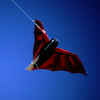|
|
Kites are truly remarkable - toys that require a thorough understanding of aerodynamics to create. Kites have been around for a long time and come in many different forms and shapes, made from many different kinds of material. Some amazing kites have been made with the most basic of material by master craftsman, mostly in southeast Asia. Today we also make kites from high tech fibers, using modern design tools. What all kites have in common is the fun that it is to fly a kite. Of course, some if this fun is very, very serious. I have made a few kites and enjoy flying them, often at the beach. Here you can find some pictures of these kites and some details on their construction. Bat-kiteThis bat kite was made from a kit. My friend Taylor and I made it together. Two kites on one flying lineYellow Box Kite
True Pink EddyThe design of this kite is based on the actual patent of Eddy, making it a rare true Eddy. Eddy's patent was for a kite without a tail: because of the bowed spar, the kite forms a dihedral, stabilizing itself without a tail. One of the most common kites in the west is the diamond shaped kite with a tail. The surface of the kite is flat and the spine and spar are on a single plane. Without a tail one could not get a diamond kite in the air as the design is aerodynamically inherently unstable. Eddy's patent was innovative in the sense that it used this common design, modified the frame into a dihedral and therefore making the tail obsolete. Simple in concept, this is a difficult kite to make. Often one sees a kite that claims to be an Eddy, but with a tail, which makes it an oxymoron.
|




